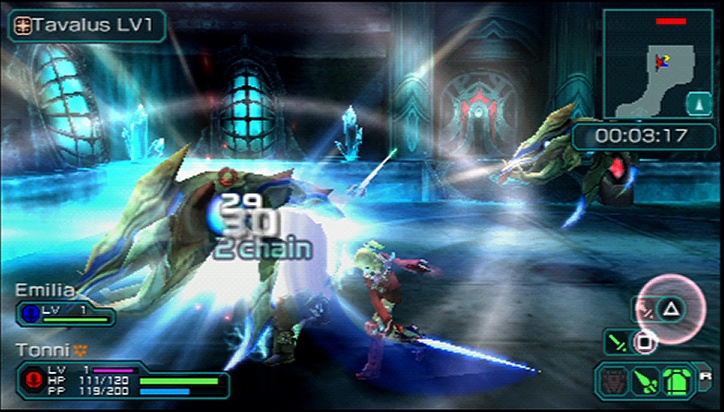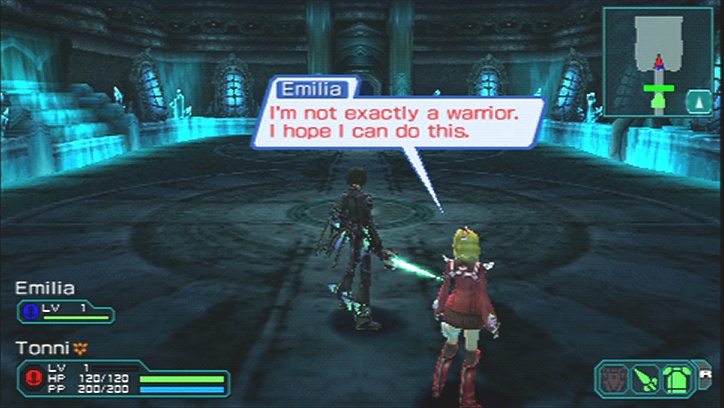Phantasy Star Portable 2 is an action role-playing game that boasts fast real-time combat and deep customization options. Its fiendishly large monsters and rich weapon variety are reminiscent of Monster Hunter, but PSP2's gameplay is more approachable. The game struggles with both wonky AI and a lack of mission variety, but the repetitive nature of the missions is less noticeable in multiplayer where even replaying them over and over again with friends can be a lot of fun. This is a challenging adventure that's enjoyable despite some defects.

The game opens in the Gurhal system three years after the defeat of the invading seed monsters. You're cast as the newest recruit of Little Wing, a mercenary group that pairs you with a young girl in the fight to save the universe. Although the plot uses simple, cliche themes, your sweet, but troubled partner draws you in as you unravel her tragic history. Interesting substories also serve to flesh out the cast, providing witty banter while you explore themes of heartbreak and loss. For example, one mission has you searching for an ally's attacked homeland, while another unveils a sad romance between two party members.
Repetitive missions mar exploration to a degree by recycling objectives and map aesthetics. Missions are divided into several types, with most giving you the task of eliminating all enemies, which grows tedious on easier difficulties. The more compelling missions test your mettle by applying time limits and restricting equipment, while both urgent and tactical missions provide intriguing side quests and a much needed change of pace. Mundane exploration is limited to large, desolate mazes, with few objects providing interactivity. The simplistic puzzles usually involve mind-numbing key collection, but a few other brainteasers--such as traps and tricky teleportation lasers--spruce up the action.
An intense real-time battle system wards off boredom by providing sufficient combat depth, lessening the game's reliance on button mashing without slowing the pace. Although you're limited to only four distinct classes--including two melee classes, a caster class, and a magical-warrior blend--you're able to use abilities from outside your class, which frees you to play more creatively. A wide variety of skills enliven the gameplay, and a fun chaining system keeps pace by restoring your ability bar each time you strike, so you'll rarely run out of energy for special skills. Chaining attacks also temporarily boosts strength, which grants you a combative edge. An intuitive blocking system lets you counter attacks if you defend immediately before a hit; blocking also reduces the status infliction rate, making it a valuable tactic during boss fights. Enemy elemental types increase tactical depth by challenging you to use the appropriate elemental gear. Ice weapons deal greater damage against fire-type opponents, for example. A highly convenient quick-select menu prevents equipment juggling from becoming a chore; you're able to instantly swap gear for the best elemental defenses and attack boons, as well as use health items.
A few irksome party-AI hiccups and combat bugs complicate battles. Although you're able to give basic tactical commands, teammates frequently ignore them or respond too slowly, often neglecting to heal you. Party members also hesitate to engage enemies and often run themselves into walls whenever you turn a corner. Some large enemies occasionally clip through you or trap you, which only worsens matters because you're unable to defend while stuck underfoot. The targeting system is slightly finicky as well, often bouncing the reticle to pick up items on the ground in the midst of fights, which can be a distraction.

Challenging enemies and multiple difficulty modes lessen mission repetitiveness. The game unveils plenty of massive monsters to hunt, including giant bugs and fire-breathing dragons. Standard enemies recycle some of the same primitive attacks, but they're far from pushovers because of optional difficulty grades, which dramatically increase a monster's level and brute strength; this feature greatly intensifies battles while boosting replayability. Numerous menacing bosses abound, and each takes some skill to outmaneuver, often inflicting your team with potent status effects.
An impressive array of customization options facilitates character personalization. You can design a persona from the ground up, tweaking everything from intricate hairstyles to kitty ears, or you can import a character from the game's predecessor. You can also change your look between missions, which motivates you to unlock accessories. You have a wealth of weapons at your disposal, ranging from lightsabers to dancing fans, as well as a slew of special skills to link to them via a simple modification process. Weapon augmentation amplifies attack power but strangely overlooks other weapon stats. Armor upgrades use a similar system, letting you summon monsters or increase character stats by linking ability modules to armor. Furthermore, you can extend your weapon proficiency beyond your class limits or change your class, which frees you to personalize your fighting style.
Multiplayer enlivens gameplay by varying objectives in both ad hoc and infrastructure modes. Both let you play through regular missions cooperatively or engage in fun player-versus-player action in battle missions, which have you capturing enemy flags, collecting money, or slaying opponents for the highest score. A convenient onscreen keyboard and auto comments help you communicate with ease, making party management painless. Lag poses a minor problem during attack chains in both modes, but unfair respawn points are more annoying, putting you at a disadvantage when you respawn on top of opponents.

Striking CG cutscenes highlight the game's key moments, while soft, subtle character artwork achieves a unique look. Characters move fluidly as they perform flashy abilities, though they're a little roughly modeled. Barren environments undermine the aesthetic appeal; areas lack textural richness for some floor paneling, while unremarkable orchestral themes and noisy attack sounds accompany exploration. Muddled combat voice-overs also detract from the presentation.
The main storyline boasts more than 40 hours of gameplay, but the figure doubles if you're inclined to battle secret bosses, complete side quests, or surpass the standard level 99 limit. Playing multiplayer and seeking unlockables also extend replayability, while customization and tough difficulty modes hook you. Though repetitive mission objectives and simplistic puzzles shortchange exploration, Phantasy Star Portable 2 offers enough features to please.